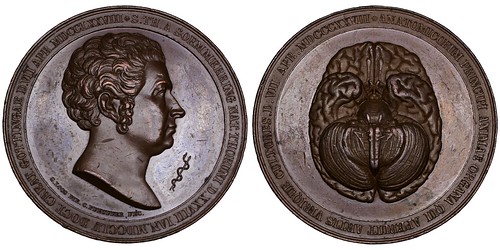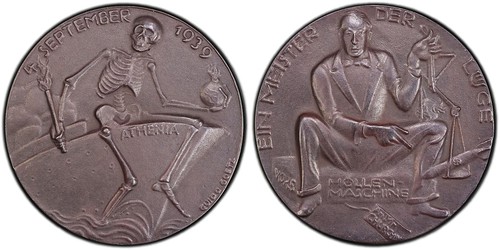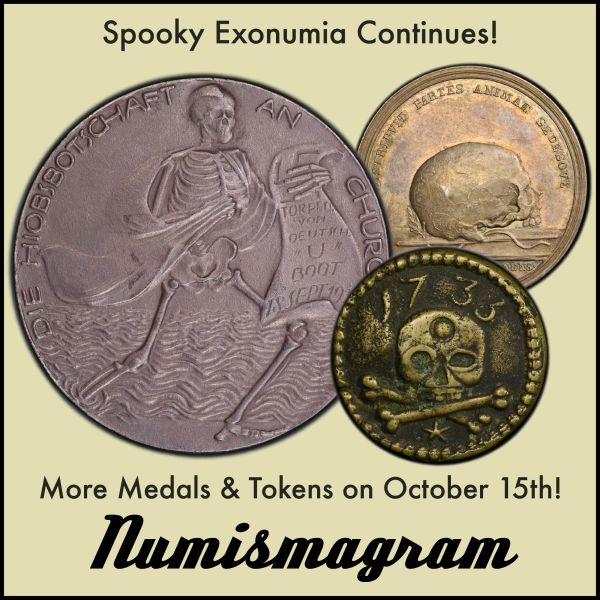
PREV ARTICLE
NEXT ARTICLE
FULL ISSUE
PREV FULL ISSUE
NUMISMAGRAM MEDAL SELECTIONS: OCTOBER 13, 2024Numismagram's Jeremy Bostwick sent along these three medals from his upload of new Halloween-themed medallic art to his site. For all of the new items, please visit https://www.numismagram.com/inventory, and be on the lookout for more being added this week! -Editor 102719 | BELGIUM. Luik (Liège). Chapter of St. Lambert's bronze Méreau or Communion Token. Dated 1686. Used for the receiving of food during feast day celebrations (20mm, 4.32 g, 6h). ANNIVERSARIVM, skull and crossbones // ECCLESI LEODI, crossbones between two flames. Edge: Plain. De Renesse pl. LXXI, 4; Revue Belge 1875, pl. V, 13. PCGS VF Details--Damage. Somewhat mottled brown surfaces; some damage near the center of the reverse. Popular and haunting type. Please note, PCGS attributes these types incorrectly, as the reference to the De Renesse plate and number should be as referenced here and not on the slab (or in the population report, for that matter). $595.
To read the complete item description, see:
102877 | GERMANY. Samuel Thomas Sömmering/Human Brain bronze Medal. Issued 1827. Commemorating the 50th anniversary of his doctorate (50mm, 72.95 g, 12h). By Christoph Pfeuffer for the Loos workshop in Berlin. S TH A SOEMMERRING NAT THORUNI D XXVIII IAN MDCCLV DOCT CREAT GOTTINGAE D VII APR MDCCLXXVIII, bare head right; serpent-entwined staff to right // ANATOMICORUM PRINCIPI ANIMAE ORGANA QUI APERUIT ARTIS VIRIQUE CULTORES D VII APR MDCCCXXVIII, view of a human brain from the top. Edge: Plain. Brettauer 1159; Sommer P-19; Joseph & Fellner 1030. Mint State. Even brown surfaces, with charming brilliance but some scattered marks. Highly interesting and haunting anatomical type. $295. One of the most important German anatomists, Samuel Thomas Sömmering received his doctorate from the University of Göttingen in 1778, for which he described the organization of the cranial nerves. During his career, he investigated the brain and nervous system, as well as sensory organs and the lungs. Of particular note, he discovered the macula in the retina of the human eye. Given this intense focus on the nervous system as a whole, the choice of a human brain on this doctorate celebratory medal is quite appropriate.
To read the complete item description, see:
102561 | GERMANY & GREAT BRITAIN. Sinking of the SS "Athenia" cast iron Medal. Dated 1939. "Totentanz (Dance of Death) Redux" type (68mm, 105.20 g, 1h). By Guido Goetz. 4 SEPTEMBER 1939, Death, as a skeleton, holding torch and lit bomb decorated with Union Jack, seated right on prow of the SS "Athenia" // EIN MEISTER DER LÜGE (the master of lies), British Prime Minister Sir Winston Churchill, holding imbalanced scale with two bombs, one decorated with Union Jack, the other with a swastika, seated facing on base inscribed VORS HÖLLEN–MASCHINE (pilot of the "hell-machine") and tagged "An Mr CHURCHILL." Edge: Plain. Engstrom 3. PCGS MS-63. Deep charcoal gray surfaces. A haunting and scarce type from the hand of not Karl Goetz, but instead his son, Guido. The only example of the type in the PCGS census. $985. Carrying on the tradition of his father, Guido Goetz also had a career as a medalist, issuing some satirical pieces in the vein of the elder Goetz, Karl. Just as World War I and its aftermath were important to the work of the father, so too was that of World War II to the son, with a number of satirical medals designed with this backdrop. Drawing upon the skeletal approach of Walther Eberbach's Totentanz series, some of Guido's issues portray Death as a skeleton taking sadistic glee in the downfall of his enemies. The SS "Athenia" was a passenger liner completed in early 1923 and utilized for transatlantic travel between the United Kingdom and Canada. In September 1939, she was hit by a torpedo from the German submarine U-30 and sank in the Western Approaches—an area in the Atlantic Ocean due west of the British Isles. This act, condemned as a war crime, represented the first instance of a British ship being sunk by Nazi Germany in World War II. 117 civilian passengers—including 28 Americans—were killed in the torpedoing and subsequent sinking of this ship. Coincidentally, a similar fate befell the "Athenia"'s namesake, in that she was torpedoed in 1917 by the Germans off the coast of Ireland, this time during World War I.
To read the complete item description, see:
Wayne Homren, Editor The Numismatic Bibliomania Society is a non-profit organization promoting numismatic literature. See our web site at coinbooks.org. To submit items for publication in The E-Sylum, write to the Editor at this address: whomren@gmail.com To subscribe go to: https://my.binhost.com/lists/listinfo/esylum All Rights Reserved. NBS Home Page Contact the NBS webmaster 
|



